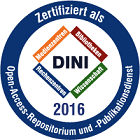Gräf, Madeleine: RIG-I-like receptors in aortic inflammation and calcification. - Bonn, 2025. - Dissertation, Rheinische Friedrich-Wilhelms-Universität Bonn.
Online-Ausgabe in bonndoc: https://nbn-resolving.org/urn:nbn:de:hbz:5-81361
Online-Ausgabe in bonndoc: https://nbn-resolving.org/urn:nbn:de:hbz:5-81361
@phdthesis{handle:20.500.11811/12869,
urn: https://nbn-resolving.org/urn:nbn:de:hbz:5-81361,
author = {{Madeleine Gräf}},
title = {RIG-I-like receptors in aortic inflammation and calcification},
school = {Rheinische Friedrich-Wilhelms-Universität Bonn},
year = 2025,
month = feb,
note = {It has been already well established that erroneous detection of endogenous nucleic acids by the innate immune system drives pathogenic processes of autoimmunity. Along with that, gain-of function mutations in the RIG-I-like receptors, RIG-I and MDA5, are associated with Singleton-Merten Syndrome. This rare interferonopathy is characterized by dental and skeletal abnormalities, as well as early and severe aortic calcification. This leads to the hypothesis that an increased availability of endogenous RNA ligands could also activate RLR without SMS mutation, resulting in a constitutive receptor activity and the development of aortic inflammation and calcification.
This thesis investigated the effect of RIG-I and MDA5 in pathogenic processes of aortic cells. For human aortic smooth muscle cells, it was determined that RLR activation did not only induce a type I IFN response, but also osteogenic differentiation was triggered. When cells were additionally cultivated in a pro-calcifying medium, the production of calcium deposits was induced. Lack of RLR or their downstream signaling molecule MAVS decreased the expression of ISGs and osteogenic factors. Additionally, calcification was reduced. Furthermore, it was revealed that the Wnt signaling molecules G3BP1 and FZD5 are both involved in osteogenic differentiation and calcification. For G3BP1, this process was clearly connected to RIG-I and MAVS, but not to MDA5, while for FZD5 no connection was revealed. Furthermore, the ISG response was reduced in G3BP1-deficient cells, suggesting a feedback loop between RIG-I/ MAVS signaling and G3BP1. The JAK-STAT pathway was shown to play a role in these processes, as its inhibition led to a reduced ISG response, decreased expression of BMP-2 and Wnt molecules, and fewer calcium particles. Even though self-RNA ligands have not been identified so far, it could be revealed that cyclic stretch on HAoSMCs induces an ISG response, even without additional RLR activation. Activation of the cGAS-STING pathway also induced an ISG response, osteogenic differentiation and calcification, but to a lower extent than RLR activation.
In human aortic endothelial cells, RLR activation also induced an ISG response. While RIG-I activation did not lead to endothelial activation, MDA5 and TLR3 stimulation with poly(I:C), induced the upregulation of proinflammatory and adhesion molecules.
In summary, this work reveals new insights into the role of RLR in aortic pathogenesis, especially in the context of osteogenic differentiation and calcification. A better understanding of the exact pathways might contribute to the development of new therapies for the treatment of calcification processes resulting from erroneous nucleic acid detection.},
url = {https://hdl.handle.net/20.500.11811/12869}
}
urn: https://nbn-resolving.org/urn:nbn:de:hbz:5-81361,
author = {{Madeleine Gräf}},
title = {RIG-I-like receptors in aortic inflammation and calcification},
school = {Rheinische Friedrich-Wilhelms-Universität Bonn},
year = 2025,
month = feb,
note = {It has been already well established that erroneous detection of endogenous nucleic acids by the innate immune system drives pathogenic processes of autoimmunity. Along with that, gain-of function mutations in the RIG-I-like receptors, RIG-I and MDA5, are associated with Singleton-Merten Syndrome. This rare interferonopathy is characterized by dental and skeletal abnormalities, as well as early and severe aortic calcification. This leads to the hypothesis that an increased availability of endogenous RNA ligands could also activate RLR without SMS mutation, resulting in a constitutive receptor activity and the development of aortic inflammation and calcification.
This thesis investigated the effect of RIG-I and MDA5 in pathogenic processes of aortic cells. For human aortic smooth muscle cells, it was determined that RLR activation did not only induce a type I IFN response, but also osteogenic differentiation was triggered. When cells were additionally cultivated in a pro-calcifying medium, the production of calcium deposits was induced. Lack of RLR or their downstream signaling molecule MAVS decreased the expression of ISGs and osteogenic factors. Additionally, calcification was reduced. Furthermore, it was revealed that the Wnt signaling molecules G3BP1 and FZD5 are both involved in osteogenic differentiation and calcification. For G3BP1, this process was clearly connected to RIG-I and MAVS, but not to MDA5, while for FZD5 no connection was revealed. Furthermore, the ISG response was reduced in G3BP1-deficient cells, suggesting a feedback loop between RIG-I/ MAVS signaling and G3BP1. The JAK-STAT pathway was shown to play a role in these processes, as its inhibition led to a reduced ISG response, decreased expression of BMP-2 and Wnt molecules, and fewer calcium particles. Even though self-RNA ligands have not been identified so far, it could be revealed that cyclic stretch on HAoSMCs induces an ISG response, even without additional RLR activation. Activation of the cGAS-STING pathway also induced an ISG response, osteogenic differentiation and calcification, but to a lower extent than RLR activation.
In human aortic endothelial cells, RLR activation also induced an ISG response. While RIG-I activation did not lead to endothelial activation, MDA5 and TLR3 stimulation with poly(I:C), induced the upregulation of proinflammatory and adhesion molecules.
In summary, this work reveals new insights into the role of RLR in aortic pathogenesis, especially in the context of osteogenic differentiation and calcification. A better understanding of the exact pathways might contribute to the development of new therapies for the treatment of calcification processes resulting from erroneous nucleic acid detection.},
url = {https://hdl.handle.net/20.500.11811/12869}
}





